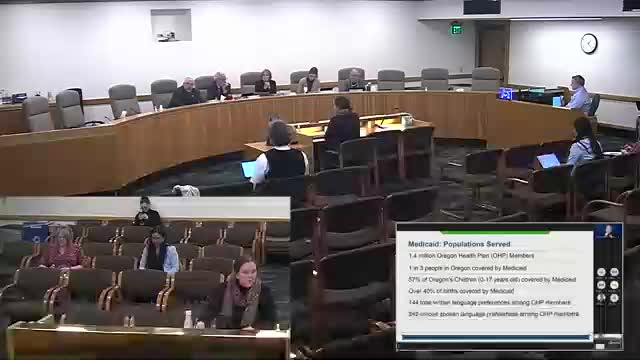Oregon expands Medicaid programs to boost access for low-income families
February 11, 2025 | Early Childhood and Behavioral Health, Senate, Committees, Legislative, Oregon
This article was created by AI summarizing key points discussed. AI makes mistakes, so for full details and context, please refer to the video of the full meeting. Please report any errors so we can fix them. Report an error »

In a recent meeting of the Oregon Senate Committee on Early Childhood and Behavioral Health, the discussion centered on the critical role of Medicaid in the lives of Oregonians. With approximately 1.4 million residents—about one in three people in the state—relying on Medicaid, the program serves as a lifeline for many families, particularly those with lower incomes.
The statistics shared during the meeting were striking: over half of the children in Oregon, specifically 57%, are covered by Medicaid, and around 40% of all births in the state are financed through this program. This reliance on Medicaid is especially pronounced among pregnant individuals, who often find it to be their only source of health insurance. The committee emphasized the importance of providing culturally and linguistically appropriate services to eliminate barriers to healthcare access.
The conversation also highlighted the complexities of the Oregon Health Plan, which encompasses various programs under the Medicaid umbrella. While the Oregon Health Plan is the primary program, there are additional initiatives like Healthier Oregon, which caters to individuals lacking the necessary immigration documentation for traditional Medicaid eligibility. This program is crucial for ensuring that vulnerable populations receive the care they need.
Another significant development discussed was the introduction of the OHP Bridal Grama, a new program designed to assist those who may earn slightly above the traditional Medicaid income limits. This initiative aims to reduce the "churning" effect—where individuals frequently move in and out of coverage—by providing a bridge between Medicaid and private health insurance exchanges.
Importantly, the committee confirmed that there is no cost-sharing for patients in these programs, as Oregon has opted to eliminate co-pays, ensuring that financial barriers do not hinder access to essential health services.
As the meeting concluded, it was clear that the Oregon Health Plan is not just a healthcare program; it is a vital support system for many families navigating the challenges of low income and health needs. The ongoing efforts to enhance and expand these services reflect a commitment to ensuring that all Oregonians have access to the care they deserve.
The statistics shared during the meeting were striking: over half of the children in Oregon, specifically 57%, are covered by Medicaid, and around 40% of all births in the state are financed through this program. This reliance on Medicaid is especially pronounced among pregnant individuals, who often find it to be their only source of health insurance. The committee emphasized the importance of providing culturally and linguistically appropriate services to eliminate barriers to healthcare access.
The conversation also highlighted the complexities of the Oregon Health Plan, which encompasses various programs under the Medicaid umbrella. While the Oregon Health Plan is the primary program, there are additional initiatives like Healthier Oregon, which caters to individuals lacking the necessary immigration documentation for traditional Medicaid eligibility. This program is crucial for ensuring that vulnerable populations receive the care they need.
Another significant development discussed was the introduction of the OHP Bridal Grama, a new program designed to assist those who may earn slightly above the traditional Medicaid income limits. This initiative aims to reduce the "churning" effect—where individuals frequently move in and out of coverage—by providing a bridge between Medicaid and private health insurance exchanges.
Importantly, the committee confirmed that there is no cost-sharing for patients in these programs, as Oregon has opted to eliminate co-pays, ensuring that financial barriers do not hinder access to essential health services.
As the meeting concluded, it was clear that the Oregon Health Plan is not just a healthcare program; it is a vital support system for many families navigating the challenges of low income and health needs. The ongoing efforts to enhance and expand these services reflect a commitment to ensuring that all Oregonians have access to the care they deserve.
View full meeting
This article is based on a recent meeting—watch the full video and explore the complete transcript for deeper insights into the discussion.
View full meeting
